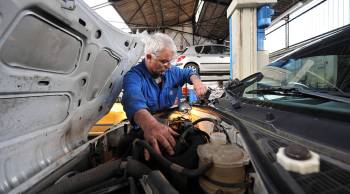Steve Chiotakis: New York and Los Angeles, on either American coast, get a lot of attention because they’re the two most populated areas. Well today new Census data will focus on the true population center of America.
Marketplace’s Economy 4.0 Special Correspondent David Brancaccio says the middle of the country moves every ten years and he’s here to talk about how our nation’s population is gravitating.
Good morning David.
David Brancaccio: Good morning.
Chiotakis: What do you mean the middle of America moves every decade?
Brancaccio: Take a piece of cardboard, cut out a map the shape of the lower 48 states, and then put a grain of rice on the cardboard where each of us lives — the entire population. Where that cardboard balances is the mean center of population distribution. Ten years ago, a town called Cuba in Missouri on old Route 66, then the new census data came in. As the population shifted south and west, it went to Edgar Springs, Mo. I telephoned a gentleman named Junior Harris in Edgar Springs and he actually tends to the grass around the commemorative plaque of the population center.
Junior Harris: See the highway 63 bypassed it. And ever since then, the population is going down within the city limits. So we only have one store and a post office, is all we have.
Brancaccio: So the economy not so great, but they do have the plaque marking the population center for the past 10 years. But that center’s now moving somewhere else.
Chiotakis: And any idea where?
Brancaccio: Apparently, according to some unconfirmed reports: Plato.
Chiotakis: Play-Doh? Like the squishy stuff?
Brancaccio: No, like the great philosopher. Plato, Mo., population: 62. Now Junior Harris guessed where it might go, and there happened to be some government surveyors taking a look at his plaque the other day.
Harris: He said, ‘No, we can’t disclose that until next Thursday.’ And I said, ‘Well I already know where it’s going.’ He looked at me and said, ‘You do?’ And I said, ‘Yeah, it’s going to Plato.’ And his eyes just locked right on me and he kind of raised his brow a little bit, like you told him something that no one else knew.
Chiotakis: David, if it is Plato, what does that tell us?
Brancaccio: Well, if that does get confirmed, it tells us the population over the past 10 years did not move quite as quickly in the southerly and westerly direction compared to the decade before. Maybe 40 miles this time, compared to about 50 miles the last time. Perhaps the crisis in the housing market is what’s the cause there. We’re not as mobile a society, possibly?
Chiotakis: Marketplace’s David Brancaccio. David, thank you.
Brancaccio: My pleasure.
There’s a lot happening in the world. Through it all, Marketplace is here for you.
You rely on Marketplace to break down the world’s events and tell you how it affects you in a fact-based, approachable way. We rely on your financial support to keep making that possible.
Your donation today powers the independent journalism that you rely on. For just $5/month, you can help sustain Marketplace so we can keep reporting on the things that matter to you.


















